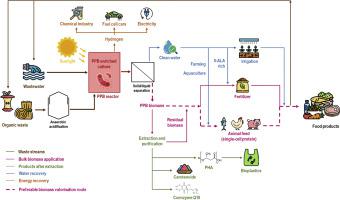Biotechnology Advances ( IF 12.1 ) Pub Date : 2020-05-26 , DOI: 10.1016/j.biotechadv.2020.107567 Gabriel Capson-Tojo 1 , Damien J Batstone 2 , María Grassino 2 , Siegfried E Vlaeminck 3 , Daniel Puyol 4 , Willy Verstraete 5 , Robbert Kleerebezem 6 , Adrian Oehmen 7 , Anish Ghimire 8 , Ilje Pikaar 9 , Juan M Lema 10 , Tim Hülsen 2

|
Sustainable development is driving a rapid focus shift in the wastewater and organic waste treatment sectors, from a “removal and disposal” approach towards the recovery and reuse of water, energy and materials (e.g. carbon or nutrients). Purple phototrophic bacteria (PPB) are receiving increasing attention due to their capability of growing photoheterotrophically under anaerobic conditions. Using light as energy source, PPB can simultaneously assimilate carbon and nutrients at high efficiencies (with biomass yields close to unity (1 g CODbiomass·g CODremoved−1)), facilitating the maximum recovery of these resources as different value-added products. The effective use of infrared light enables selective PPB enrichment in non-sterile conditions, without competition with other phototrophs such as microalgae if ultraviolet-visible wavelengths are filtered. This review reunites results systematically gathered from over 177 scientific articles, aiming at producing generalized conclusions. The most critical aspects of PPB-based production and valorisation processes are addressed, including: (i) the identification of the main challenges and potentials of different growth strategies, (ii) a critical analysis of the production of value-added compounds, (iii) a comparison of the different value-added products, (iv) insights into the general challenges and opportunities and (v) recommendations for future research and development towards practical implementation. To date, most of the work has not been executed under real-life conditions, relevant for full-scale application. With the savings in wastewater discharge due to removal of organics, nitrogen and phosphorus as an important economic driver, priorities must go to using PPB-enriched cultures and real waste matrices. The costs associated with artificial illumination, followed by centrifugal harvesting/dewatering and drying, are estimated to be 1.9, 0.3–2.2 and 0.1–0.3 $·kgdry biomass−1. At present, these costs are likely to exceed revenues. Future research efforts must be carried out outdoors, using sunlight as energy source. The growth of bulk biomass on relatively clean wastewater streams (e.g. from food processing) and its utilization as a protein-rich feed (e.g. to replace fishmeal, 1.5–2.0 $·kg−1) appears as a promising valorisation route.
中文翻译:

紫色光养细菌用于资源回收:挑战与机遇。
可持续发展正在推动废水和有机废物处理领域的重点快速转移,从“清除和处置”方式向水,能源和材料(例如碳或养分)的回收和再利用。紫色光养细菌(PPB)由于其在厌氧条件下光异养生长的能力而受到越来越多的关注。使用光作为能源,PPB可以同时高效吸收碳和养分(生物量产量接近于单位(1 g COD生物量·g g COD去除-1)),以最大限度地回收这些资源作为不同的增值产品。有效地利用红外光可以在非无菌条件下选择性富集PPB,如果滤除了紫外线可见光波长,则不会与其他微养藻如微藻竞争。这篇综述重新整合了从177余篇科学文章中系统收集的结果,旨在得出广义的结论。解决了基于PPB的生产和增值过程的最关键方面,包括:(i)确定不同增长策略的主要挑战和潜力,(ii)对增值化合物的生产进行关键分析,(iii )不同增值产品的比较,(iv)对一般挑战和机遇的见解,以及(v)为未来研究和开发向实际实施提供建议。迄今为止,大多数工作尚未在现实条件下执行,这与大规模应用有关。由于去除有机物,氮和磷是重要的经济驱动因素,从而节省了废水排放,因此必须优先使用富含PPB的培养物和真实的废物基质。人工照明,离心收获/脱水和干燥所需的费用估计为1.9 氮和磷是重要的经济驱动力,必须优先使用富含PPB的培养物和真实的废物基质。人工照明,离心收获/脱水和干燥所需的费用估计为1.9 氮和磷是重要的经济驱动力,必须优先使用富含PPB的培养物和真实的废物基质。人工照明,离心收获/脱水和干燥所需的费用估计为1.9, 0.3–2.2和0.1–0.3 $·kg干生物量-1。目前,这些成本可能超过收入。未来的研究工作必须在户外使用阳光作为能源。相对清洁的废水流(例如,来自食品加工的过程)中散装生物量的增长以及将其用作富含蛋白质的饲料(例如,代替鱼粉1.5–2.0 $·kg -1)似乎是一种有前途的增值途径。











































 京公网安备 11010802027423号
京公网安备 11010802027423号